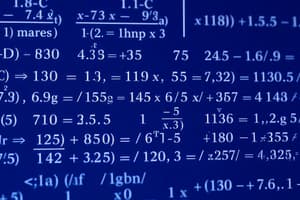Podcast
Questions and Answers
What is the value of $5^0$?
What is the value of $5^0$?
- 1 (correct)
- 0
- 5
- Undefined
Using the product rule of indices, what is the simplified form of $x^3 * x^5$?
Using the product rule of indices, what is the simplified form of $x^3 * x^5$?
- $x^{-2}$
- $x^{1.5}$
- $x^{15}$
- $x^8$ (correct)
Which of the following correctly describes the quotient rule of indices?
Which of the following correctly describes the quotient rule of indices?
- $a^m / a^n = a^{m+n}$
- $a^m / a^n = a^{m-n}$ (correct)
- $a^m / a^n = a^{m*n}$
- $a^m / a^n = a^{-m-n}$
What is the result of $log_{10}(100)$?
What is the result of $log_{10}(100)$?
Which statement correctly describes logarithms?
Which statement correctly describes logarithms?
Using the power rule of logarithms, how would you simplify $log_2(8)$?
Using the power rule of logarithms, how would you simplify $log_2(8)$?
Determine the logarithm value of $log_e(1)$ using the logarithm rules.
Determine the logarithm value of $log_e(1)$ using the logarithm rules.
If $y = 2^x$, what is the equivalent logarithmic form?
If $y = 2^x$, what is the equivalent logarithmic form?
Flashcards
Index (Exponent)
Index (Exponent)
A number that indicates how many times a base is multiplied by itself.
Product Rule of Indices
Product Rule of Indices
When multiplying terms with the same base, add the exponents.
Quotient Rule of Indices
Quotient Rule of Indices
When dividing terms with the same base, subtract the exponents.
Power Rule of Indices
Power Rule of Indices
Signup and view all the flashcards
Zero Index Rule
Zero Index Rule
Signup and view all the flashcards
Negative Index Rule
Negative Index Rule
Signup and view all the flashcards
Logarithm
Logarithm
Signup and view all the flashcards
Logarithm Product Rule
Logarithm Product Rule
Signup and view all the flashcards
Logarithm Quotient Rule
Logarithm Quotient Rule
Signup and view all the flashcards
Logarithm Power Rule
Logarithm Power Rule
Signup and view all the flashcards
Change of Base Rule
Change of Base Rule
Signup and view all the flashcards
Logarithm of 1
Logarithm of 1
Signup and view all the flashcards
Logarithm of the Base
Logarithm of the Base
Signup and view all the flashcards
Scientific Notation
Scientific Notation
Signup and view all the flashcards
Compound Interest
Compound Interest
Signup and view all the flashcards
Inverse Operations
Inverse Operations
Signup and view all the flashcards
Fundamental Relationship (Indices & Logarithms)
Fundamental Relationship (Indices & Logarithms)
Signup and view all the flashcards
Study Notes
Indices
- Indices, also known as exponents, represent repeated multiplication of a number.
- A general expression for an index is an, where 'a' is the base and 'n' is the index (or exponent).
- The base 'a' is the number being multiplied repeatedly.
- The index 'n' indicates how many times the base is used as a factor in the multiplication.
- Positive indices represent repeated multiplication.
- Negative indices represent repeated division.
- Zero indices always evaluate to 1 (assuming the base is not zero).
Rules of Indices
- Product rule: am * an = a(m+n)
- Quotient rule: am / an = a(m-n)
- Power rule: (am)n = a(m*n)
- Zero index rule: a0 = 1 (a ≠ 0)
- Negative index rule: a-n = 1/an (a ≠ 0)
Logarithms
- Logarithms are the inverse of exponentiation.
- They answer the question: "To what power must a base be raised to obtain a given number?"
- The most common logarithm is the base-10 logarithm, often denoted as log10(x) or simply log(x).
- The natural logarithm uses Euler's number, e, as its base, and is denoted as loge(x) or ln(x).
- Logarithms offer a way to simplify complex calculations involving very large or very small numbers.
Logarithm Rules
- Product rule: logb(xy) = logb(x) + logb(y)
- Quotient rule: logb(x/y) = logb(x) - logb(y)
- Power rule: logb(xy) = y * logb(x)
- Change of base rule: logb(x) = loga(x) / loga(b)
- Logarithm of 1: logb(1) = 0
- Logarithm of the base: logb(b) = 1
Applications of Indices and Logarithms
- Scientific notation: Useful for expressing very large or very small numbers compactly.
- Compound interest calculations: To determine the future value of an investment.
Relationship Between Indices and Logarithms
- Exponentiation and logarithm are inverse operations.
- If y = bx, then logb(y) = x. This is the fundamental relationship between indices and logarithms.
- This allows solving for unknown exponents using logarithms or for unknown base cases using logarithms.
Examples
- If 23 = 8, then log2(8) = 3.
- If log10(1000) = 3, then 103 = 1000.
Studying That Suits You
Use AI to generate personalized quizzes and flashcards to suit your learning preferences.




